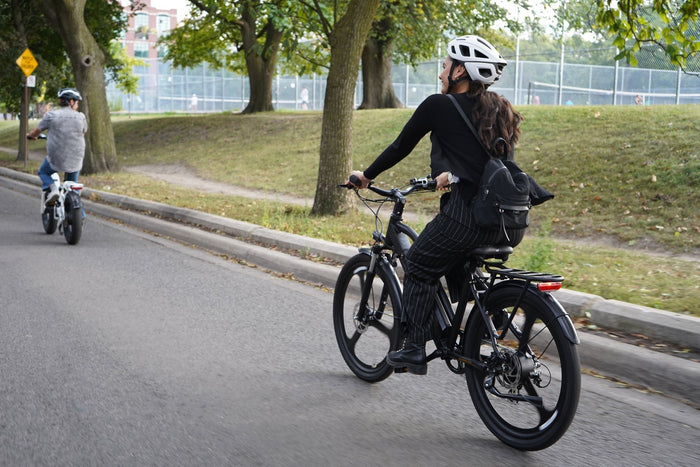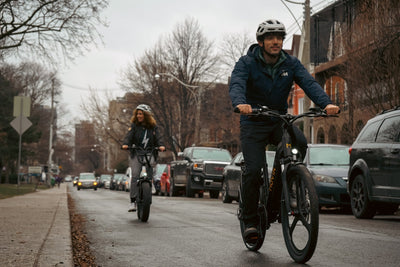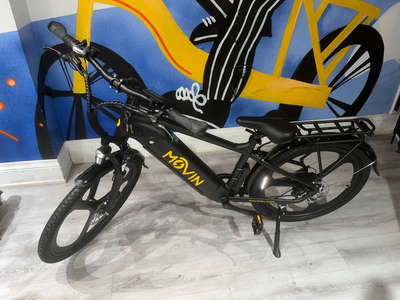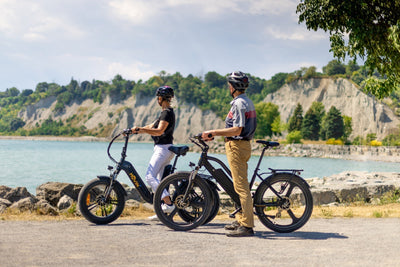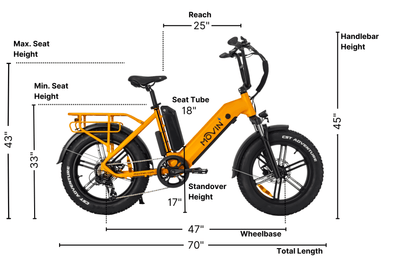Welcome to our comprehensive guide for choosing a woman's e-bike. Selecting the perfect electric bike involves considering various factors, from frame design and color preferences to essential features and accessories. In this guide, we'll explore key elements to help you make an informed decision, ensuring you find the ideal e-bike that meets your needs and enhances your riding experience. Whether you're looking for a stylish commuter bike, a comfortable leisure ride, or a high-performance model, we've got you covered. Let's dive into the details!
Introducing Movin's Best E-Bikes for Women
- Movin' Pulse: Ideal for leisurely rides, winter trips, or food delivery
Light and Comfortable: The Movin' Pulse is designed for women who prefer a relaxed, comfortable ride. With its ergonomic design and padded saddle, it's perfect for leisurely rides around the city or park..
Great for Winter: This model stands out with its fat tires, making it ideal for winter trips. The wider tires provide better traction and stability on snow and ice, ensuring a safe ride even in colder weather.
Perfect for Food Delivery: With a powerful motor and sturdy build, the Movin' Pulse can handle the extra weight of food delivery, making it a reliable choice for women looking to combine their passion for cycling with work.
- Movin' Tempo: Perfect for sports enthusiasts and an active lifestyle
High Performance: The Movin' Tempo is geared towards women who love sports and an active lifestyle. Its high-torque motor and multiple speed settings allow for an energetic ride, whether you're on a casual ride or pushing your limits.
Lightweight Frame: This model features a lightweight aluminum frame, making it easy to handle and maneuver, especially for sports activities.
Efficient Braking System: Equipped with advanced disc brakes, the Movin' Tempo ensures quick and safe stops, providing extra security for those who ride at higher speeds.
- Movin' Small Folding: Perfect for short travels and easy lifestyle
Compact and Portable: The Movin' Small Folding bike is perfect for women who need an e-bike that's easy to carry and store. Its folding mechanism allows it to fit into small spaces, making it ideal for urban dwellers or those with limited storage.
Lightweight Design: This model is one of the lightest in the lineup, making it easy to carry upstairs or onto public transport.
Versatile Use: Despite its small size, the Movin' Small Folding bike offers a versatile ride, whether you're commuting to work or enjoying a weekend ride.
Key Features of Women's Electric Bikes
Frame Design: Step-through frames are a common feature in women's e-bikes, providing easy mounting and dismounting. This design is particularly useful for women wearing skirts or dresses and offers greater comfort and convenience.
Lightweight Construction: Women's e-bikes often have a lighter construction, enhancing handling and maneuverability. This makes it easier for riders to navigate different terrains and transport their bikes when needed.
Comfortable Seating: Ergonomic saddles and adjustable seat posts are essential for providing a comfortable riding experience. These features ensure that women can ride longer distances without discomfort, adapting the bike to their preferred height and posture.
Adjustable Handlebars: To ensure a comfortable riding posture, adjustable handlebars are a key feature. They allow riders to customize the handlebar height and angle, reducing strain on the back and shoulders and promoting a more relaxed ride.
What Color to Choose for Ebikes for Women's?
Surprisingly, color can be one of the most controversial topics when buying an electric bicycle. Would a woman buy an electric bicycle in a color she doesn't like? Most likely, no. We all have color preferences. Women like everything that belongs to them to be comfortable and fashionable.
While some would like the electric bicycle to be bright and attractive, others would prefer cool or dark colors. So, thoroughly discuss and think about color preferences if you are going to buy an electric bicycle for a woman.
White, black, pink, cream, dark green, dark blue, yellow, or orange are some of the most commonly used colors for such electric bicycles.
Other Details to Consider When Choosing Ebikes for Women's
Choosing the perfect bicycle for a woman can be a tiring and sometimes frustrating task initially. However, it's a manageable exercise.
Just as there are different items designed for different genders, there are also different electric bicycles designed for different genders, depending on age, body type, personal taste, and technical specifications.
Manufacturers know the preferences of their customers, hence the multitude of models, colors, and specifications. When choosing a bicycle for a woman, it is recommended to select bicycles specifically designed for them.
Accessories for Ebikes for Womens
Accessories are where ladies can express their taste, choosing all that is fashionable and decorative. You can select a bicycle design to your liking. Most importantly, you can choose various accessories that you can show off in any weather.
1. Helmets with Visors
- Designed for safety and sun protection, helmets with built-in visors protect the face from sunlight and ensure visibility is not compromised.
2. Panniers and Saddle Bags
- Stylish and functional bags that attach to the rear rack, perfect for carrying personal items, groceries, or work essentials. They come in various designs to match different styles and needs.
3. Basket Front
- A front basket is ideal for quick trips to the store or carrying a small pet. They add a classic look to the e-bike and offer convenient access to belongings.
4. Comfort Saddles
- Ergonomic saddles designed to fit the female anatomy provide enhanced comfort during long rides, reducing pressure and preventing soreness.
5. Gel Seat Covers
- For extra cushioning and comfort, gel seat covers can be placed over the existing saddle, making longer rides more comfortable.
6. Handlebar Grips
- Ergonomically designed grips that reduce pressure on the hands and wrists, preventing numbness and fatigue on longer journeys.
7. E-Bike Lighting
- LED lights for the front and rear, including rechargeable options, ensure visibility during night rides or in low-light conditions.
8. Reflective Clothing and Gear
- Reflective vests, jackets, and stickers enhance visibility to other road users, crucial for safety during dusk or dawn rides.
9. Locks
- High-quality U-locks or folding locks specifically designed for e-bikes offer security and peace of mind when parking the bike in public places.
10. Portable Tire Pump and Repair Kits
- Compact and easy to carry, these kits are essential for addressing flat tires or minor repairs on the go, ensuring riders are not stranded.
11. Water Bottle Holder
- Hydration is key, and a water bottle holder mounted to the frame or handlebars allows easy access to water without having to stop.
12. GPS Tracker
- A discreet GPS tracker can help locate the e-bike if it's stolen, providing an additional layer of security.
13. Kickstand
- A durable and adjustable kickstand makes it easier to park the e-bike anywhere without worrying about finding a place to lean it.
14. Bell or Horn
- A bell or horn with a clear, loud sound is essential for signaling presence to pedestrians and other cyclists, enhancing safety on shared paths.
15. Fenders
- Fenders or mudguards protect the rider from splashes during rainy rides, keeping clothing clean.
When choosing accessories, it's important to consider the specific needs and riding habits of the woman using the e-bike, ensuring that each accessory adds value to her cycling experience.
How women can protect her ebike
Protecting an e-bike involves a combination of physical security measures, technology, and common sense practices. Here are strategies that women (and indeed any e-bike owner) can employ to safeguard their electric bicycle:
1. Use High-Quality Locks
- Invest in a high-quality U-lock, chain lock, or folding lock. U-locks are tough to break, but for the best protection, use it in conjunction with a chain lock.
- Lock both the frame and the wheels to an immovable object. If you have quick-release wheels, consider using additional locks or replacing quick-release skewers with ones that require tools.
2. Smart Locks and Alarms
- Some e-bikes come with integrated smart locks that can be controlled via a smartphone app, providing additional security features such as alarm systems, GPS tracking, and the ability to remotely lock or unlock the bike.
- Aftermarket bike alarms can also deter thieves. These alarms emit a loud sound when they detect motion, drawing attention to any unauthorized attempts to move the bike.
3. GPS Trackers
- Installing a hidden GPS tracker can help you locate your e-bike if it's stolen. Make sure the tracker is discreetly placed and hard to remove.
- Choose a tracker with a long battery life or one that can be wired directly into the e-bike’s power source.
4. Register Your E-Bike
- Register your e-bike with national and local bike registration services. This can help police identify and return your bike if it's recovered after being stolen.
- Keep a record of your e-bike’s serial number, make, model, and any unique features. Photos can also help identify and recover your bike.
5. Secure Home Storage
- When not in use, store your e-bike in a locked garage or shed. If you must keep it indoors, consider using a ground anchor and lock to secure it.
- Be mindful of visibility; try not to store your bike where it's easily seen from the outside to avoid tempting potential thieves.
6. Use Bike Parking Facilities
- Whenever possible, park your e-bike in designated bike parking areas that are well-lit and highly visible. These areas are often monitored by surveillance cameras, adding an extra layer of security.
- In urban areas, some parking garages offer secure bike lockers or monitored bike parking spaces.
7. Insurance
- Consider getting insurance coverage for your e-bike. Some homeowner's or renter's insurance policies can be extended to include e-bikes, or you might need a separate policy.
- Insurance can offer peace of mind by covering theft, damage, and sometimes even personal liability.
8. Personal Awareness
- Be Always aware of your surroundings when parking your e-bike. Choose locations that are well-traveled and avoid leaving your bike in the same spot too frequently, which can make it a target.
- When locking up, make the lock as difficult to access as possible; keep it off the ground and away from walls or posts where leverage could be used to break it.
By combining these measures, women can significantly reduce the risk of e-bike theft and ensure their valuable mode of transportation remains secure.
Choosing the Right E-Bike for You
Assess Your Needs: Consider your riding style, terrain, and frequency of use. Whether you need an e-bike for commuting, leisure, or sports, identifying these factors will help narrow down your options.
Test Ride: Experience the comfort and performance of Movin' e-bikes firsthand. Taking a test ride allows you to feel the difference in design, weight, and handling, ensuring you choose the perfect fit.
Consult Experts: Get advice tailored to your specific requirements. Our knowledgeable staff can guide you in selecting the best e-bike for your needs. You can sign up for a test ride at our company store in Toronto.
